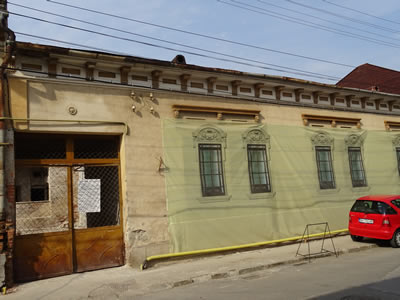Historic Buildings - Old Town
The city on the western plateau of the medieval fortress was devastated following the Turk and Tartar attacks in 1658 and 1661-1662. Urban life was revived in Alba Iulia when the inhabitants from the surroundings of the future bastionary citadel called Alba Carolina were relocated here. This relocation was carried out in an organized fashion, but rather slowly due to the marshes and the frequent devastating floods occurring in 1851, 1857, 1870, 1887, 1893, 1970 and 1975. Consequently, elevated areas were used with priority. It was because of the dampness and the floods we mentioned that mostly churches and not so many private homes survived to the present day. The private houses are grouped within the following urban ensembles: " George Coşbuc Street" (no. 2-26, 11-27, especially houses no. 12, 14 and 17), "Decebal Street"(no. 2), "Ferdinand I Boulevard" (no. 1-35, 2-26, especially the buildings at no. 2, 4, 7, 11, 12, 16, 19-21 and 26), "Primăverii Street" (no. 3, 5-7, 9, 11, 12, 16 and 22), "Teilor Street" (no. 6, 8, 9, 10, 11, 12, 13, 15 and 17) and "Trandafirilor Street".
As land drained, paved streets and squares as well as storey houses appeared, but the great majority of them were demolished in the 1980s. As a general characteristic, two-storey houses alternated with one-storey buildings in the mentioned ensembles, the latter category being nevertheless predominant. Next to these buildings, the allotting made it also possible to preserve large surfaces used for household outbuildings or for agricultural activities, thus creating a rather rural aspect for the new dwelling, in spite of the fact that it was administratively declared a city. It is enough to mention the fact that the two Roman cities called Apulum were more extensive than Alba Iulia was in the 1940s.
The houses ensembles only survived in the quarters named after the old plans of the “Hungarian city” and the ”German city”. Even though people of different ethnicities lived here, their common point was their economic well-being, which allowed them to purchase or build a house in this area. Unfortunately, the older private houses dating from the 18th century were not preserved because of the excessive dampness of the land. The oldest house still preserved today seems to be the building at no. 6, Teilor Street bearing an inscription on the portal reading “1810”.
The most valuable edifices from an architectural point of view were unfortunately demolished by the communist regime, the value of those which remained standing being a rather memorial one due to the personalities who lived in them, such as Camil Velican or Rubin Patiţia. However, these buildings are worth preserving because they testify of a historical reality in the past of Alba Iulia city.










